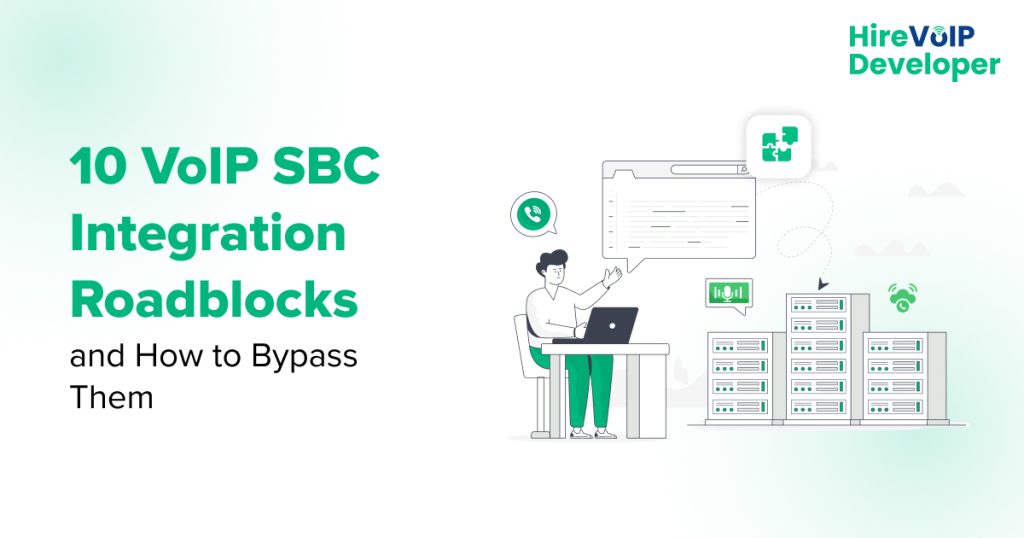With the increasing adoption of Voice over Internet Protocol (VoIP) technologies, businesses continually seek robust and secure solutions to manage their communication networks. The Session Border Controller (SBC) is a critical component in this ecosystem. Integrating SBCs into enterprise networks can pose several challenges, from ensuring seamless interoperability to maintaining high levels of security and performance. In this blog post, we will delve into these challenges and offer solutions for effective SBC integration in VoIP environments.
Understanding VoIP SBCs
Session Border Controllers (SBCs) are specialized network devices that manage and secure VoIP communications. They are essential for providing robust and reliable VoIP services in enterprise environments. SBCs perform various functions, including:
- Security: SBCs protect the VoIP network from various security threats, including DoS attacks, fraud, and eavesdropping. They provide encryption and other security measures to ensure that voice communications are secure and confidential.
- Interoperability: SBCs ensure compatibility between different VoIP protocols and devices. It is crucial for businesses that use a variety of VoIP solutions from other vendors, as SBCs can translate between different signaling protocols and codecs, allowing seamless communication.
- Quality of Service (QoS): SBCs manage and prioritize VoIP traffic to maintain high-quality voice communications. They monitor network conditions and adjust voice traffic flow to prevent delays, jitter, and packet loss, ensuring a precise and reliable communication experience.
- Session Management: SBCs handle the setup, maintenance, and termination of VoIP calls. They also manage call signaling and media streams, ensuring that calls are established and maintained throughout the communication session.
By performing these functions, SBCs play a critical role in maintaining VoIP networks’ performance, security, and interoperability, making them indispensable for enterprises that rely on VoIP for their communication needs.
10 Common Challenges and Solutions in VoIP SBC Integration
Here, we will explore ten common VoIP SBC integration challenges and provide practical solutions to overcome them. Understanding these challenges and solutions will help ensure a smooth and efficient SBC deployment process, whether you’re an IT professional, network administrator, or business leader.
1. Interoperability Issues
One of the primary challenges in SBC integration is ensuring interoperability between different VoIP systems, devices, and protocols. Enterprises often use a mix of legacy and modern systems, leading to compatibility issues.
To address interoperability issues, enterprises should choose an SBC that supports a wide range of protocols and codecs. Comprehensive VoIP testing and validation of SBCs with existing systems are essential. Implementing open-source SBC VoIP solutions can also provide flexibility and customization options. Regular firmware updates and vendor support help maintain compatibility as new protocols and devices emerge.
2. Security Concerns
VoIP systems are susceptible to security threats, such as Denial of Service (DoS) attacks, eavesdropping, and fraud. Ensuring robust security during SBC integration is paramount to protect sensitive communications.
Implementing enterprise session border controllers with advanced security features is crucial. These features may include encryption, firewall capabilities, intrusion detection, and prevention systems. Regular security audits and updates should be conducted to address emerging threats. Configuring SBCs to enforce strict access controls and authentication mechanisms will enhance overall security.
3. Network Performance and Quality of Service (QoS)
Maintaining high-quality voice calls and minimizing latency and jitter is a significant challenge in SBC integration. Network congestion and inadequate bandwidth allocation can degrade call quality.
SBCs should be configured to prioritize VoIP traffic using QoS policies to ensure optimal network performance. Implementing bandwidth management and traffic shaping techniques can help allocate sufficient resources for VoIP calls. Monitoring tools can offer real-time insights into network performance, allowing proactive measures to address potential issues. Collaborating with an experienced SBC enterprise solutions provider can ensure the deployment of robust QoS strategies.
Don't fall behind – explore the latest VoIP integration techniques. Upgrade Your Network Today!
4. Scalability and Performance
As businesses grow, their communication needs evolve. Ensuring the SBC infrastructure can scale to accommodate increased traffic and users is a critical challenge.
Choosing an SBC solution that offers scalability is essential. Enterprises should opt for SBCs that support modular expansion, allowing additional capacity to be added as needed. A scalable SBC architecture ensures the system can handle future growth without compromising performance. Regular capacity planning and performance testing can anticipate and address scalability challenges.
5. Configuration Complexity
Configuring SBCs for enterprise networks can be complex and time-consuming. Incorrect configurations can lead to service disruptions and security vulnerabilities.
Enterprises should leverage automated configuration tools and templates provided by SBC vendors to simplify the configuration process. Comprehensive documentation and training for IT staff are essential to ensure accurate and efficient configuration. Engaging with an SBC development partner can provide expert guidance and support during integration. Regular audits and reviews of SBC configurations can help identify and rectify potential issues.
6. Regulatory Compliance
Enterprises operating in regulated industries must ensure that their VoIP systems comply with industry-specific regulations and standards. Non-compliance may result in financial and legal consequences.
Selecting an SBC solution that adheres to relevant regulatory requirements is crucial. Enterprises should conduct thorough research to understand their industry’s specific compliance needs. Working with vendors with experience in regulatory compliance can provide valuable insights and solutions. Regular audits and updates to the SBC configuration can help maintain compliance with evolving regulations.
7. Integration with Legacy Systems
Many enterprises still rely on legacy telephony systems and infrastructure. Integrating SBCs with these legacy systems can be challenging due to differences in technology and protocols.
Implementing SBCs that support a wide range of legacy protocols and interfaces is essential. Enterprises should thoroughly assess their existing infrastructure to identify potential compatibility issues. Collaborating with vendors that offer customized integration solutions can help bridge the gap between modern systems and legacy. Regular validation and testing are crucial to ensure seamless integration and operation.
8. Cost Management
The cost of SBC integration, including hardware, software, licensing, and maintenance expenses, can be significant. Managing these costs while ensuring a robust SBC deployment is a common challenge.
Enterprises should conduct a cost-benefit analysis to understand the long-term value of SBC integration. Opting for open-source Custom SBC VoIP solutions can reduce software licensing costs. Leveraging cloud-based SBC services can also provide cost-effective scalability and maintenance options. Establishing a clear budget and working with experienced vendors can help manage costs effectively.
9. Monitoring and Troubleshooting
Maintaining continuous monitoring and efficient troubleshooting of SBCs is essential to ensuring optimal performance and reliability. However, identifying and resolving issues in real-time can be challenging.
Implementing advanced monitoring and analytics tools is crucial for real-time visibility into SBC performance. Enterprises should establish robust alerting and reporting mechanisms to detect and address issues promptly. Regular training for IT staff on troubleshooting best practices can enhance their ability to resolve problems efficiently. Collaborating with vendors that offer comprehensive support and maintenance services can ensure ongoing monitoring and troubleshooting capabilities.
10. User Training and Adoption
Ensuring end-users and IT staff are well-trained and comfortable with the new SBC-integrated VoIP system is essential for successful adoption. Lack of training can lead to user frustration and decreased productivity.
Providing comprehensive training programs for both end-users and IT staff is crucial. Training should cover system usage, configuration, troubleshooting, and best practices. Resources and ongoing support, such as user manuals and online tutorials, can help users become proficient with the new system. Conducting regular feedback sessions and addressing user concerns promptly can facilitate smooth adoption and maximize the benefits of SBC integration within enterprise VoIP solutions.
Integrating Session Border Controllers into enterprise VoIP systems presents various challenges, from interoperability and security concerns to scalability and cost management. However, by understanding these challenges and implementing the solutions, businesses can achieve a successful and efficient SBC deployment process.
🧩 Struggling with SBC integration challenges? Let’s solve them together.
Wrapping Up
In this blog, we explored ten common challenges faced during VoIP SBC integration and provided practical solutions to overcome them. By overcoming these challenges with the recommended solutions from the experts at Hire VoIP Developer, enterprises can ensure a smooth and efficient SBC deployment process. Our solutions help companies unlock the full potential of their VoIP systems, ensuring seamless and reliable communication. Whether you’re dealing with interoperability issues, security concerns, or scalability challenges, our expertise will guide you through a successful SBC integration.



